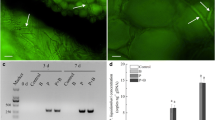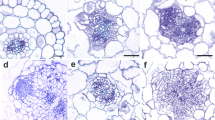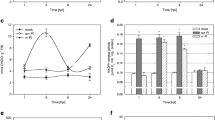Abstract
The content of NO and H2O2 as well as the activities of nitric oxide synthase (NOS)-like and nitrate reductase (NR) were monitored in the needles of Pinus thunbergii infected by Bursaphelenchus xylophilus. The results showed that the content of NO increased significantly only 8 h after the invasion of B. xylophilus, while H2O2 increased 12 h after invasion. NO donor SNP could promote and NO scavenger cPTIO could prevent the production of NO and H2O2. The content of NO changed earlier than that of H2O2. In addition, the symptoms appeared 9, 5 and 12 days, respectively, after the inoculation with B. xylophilus, SNP pre-treatment and cPTIO pre-treatment followed by B. xylophilus infection. After B. xylophilus infection, the content of NO in P. thunbergii changed fiercely more earlier than the appearance of external symptoms, which indicated that the content of NO was related with the appearance and the development of the symptoms. The treatment with l-NNA (NOS inhibitor) inhibited the content of NO significantly, whereas, Na2WO4 (NR inhibitor) had no effect. The further analysis of NOS revealed that NO changed in consistent with cNOS activity. To sum up, NO, as the upstream signal molecule of H2O2, was involved in the pine early response to the invasion of B. xylophilus and influenced the accumulation of the content of H2O2. Moreover, NOS-like rather than NR was responsible for the endogenous NO generation, which was modulated by cNOS during the interaction between P. thunbergii and B. xylophilus.
Key message NO is involved in early response of P. thunbergii to the invasion of B. xylophilus and NOS is the key enzyme responsible for NO generation in P. thunbergii.





Similar content being viewed by others
References
Bradford MM (1976) A rapid and sensitive method for the quantitation of mircogram quantities of protein utilizing the principle of protein dye binding. Anal Biochem 72:248–254
Chen YH, Ye JR, Wei CJ, Yang XM (2002) Effects of pine wood nematode infection on metabolism of active oxygen in Japanese black pine and slash pine seedlings. J Nanjing For Univ 26:19–23
Delledonne M (2005) NO news is good news for plants. Curr Opin Plant Biol 8:390–396
Delledonne M, Xia Y, Dixon RA, Lamb C (1998) Nitric oxide functions as a signal in plant disease resistance. Nature 394:585–588
Dong Y, Liu LQ, Guan JF (2011) Effects of 1-methylcyclopropene on NO content, NOS activity, and H2O2 content in postharvest Suli pears. Agri Sci China 10:797–804
Durner J, Wendehenne D, Klessig DF (1998) Defense gene induction in tobacco by nitric oxide, cyclic GMP, and cyclic ADP-ribose. Proc Natl Acad Sci USA 95:10328–10333
Fukuda K (1997) Physiological process of the symptom development and resistance mechanism in pine wilt disease. J For Res 2:171–181
Hancock JT, Desikan R, Clarke A, Hurst RD, Neill SJ (2002) Cell signalling following plant/pathogen interactions involves the generation of reactive oxygen and reactive nitrogen species. Plant Physiol Biochem 40:611–617
He LX, Wu XQ, Yu LZ, Ji J, Ye JR (2010) The difference of H2O2 and oxidative enzyme in the interaction of different resistance pines and Bursaphelenchus xylophilus. J Nanjing For Univ 34:13–18
Jin G, Ye JR (2007) Histopathological study on the nematode in seedling of Pinus thunbergii. J Nanjing For Univ 31:115–121
Kuroda K (2008) Physiological incidences related to symptom development and wilting mechanism. In: Zhao BG (ed) Pine wilt disease, 1st edn. Springer, Japan, pp 204–222
Lebeda A, Sedlářová M, Petřivalský M, Prokopová J (2008) Diversity of defence mechanisms in plant-oomycete interactions: a case study of Lactuca spp. and Bremia lactucae. Eur J Plant Pathol 122:71–89
Levine A, Tenhaken R, Dixon R, Lamb C (1994) H2O2 from the oxidative burst orchestrates the plant hypersensitive disease resistance response. Cell 79:583–593
Liao WB, Xiao HL, Zhang ML (2009) Role and relationship of nitric oxide and hydrogen peroxide in adventitious root development of marigold. Acta Physiol Plant 31:1279–1289
Liu J, Wu XQ, He LX, Ying CX (2008) Study on superoxide anion of Pinus thunbergii infected by Bursaphelenchus xylophilus and B. mucronatus in the earlier interaction. J Nanjing For Univ 32:24–29
Malolepsza U, Różalska S (2005) Nitric oxide and hydrogen peroxide in tomato resistance: nitric oxide modulates hydrogen peroxide level in o-hydroxyethylorutin-induced resistance to Botrytis cinerea in tomato. Plant Physiol Biochem 43:623–635
Millar AH, Day DA, Mathieu C (2002) Nitric oxide synthesis by plants and its potential impact on nitrogen and respiratory metabolism. In: Foy er CH, Noctor G (eds) Photosynthetic nitrogen assimilation and associated carbon and respiratory metabolism. Kluwer Academic Publishers, Netherlands, pp 193–204
Neill S, Bright J, Desikan R, Hancock J, Harrison J, Wilson I (2008) Nitric oxide evolution and perception. J Exp Bot 59:25–35
Nie GH, Wang WQ (2009) Advances and prospects of control method of Bursaphelenchus xylophilus. J Anhui Agri Sci 37:11612–11613
Orozco-cardenas M, Ryan CA (1999) Hydrogen peroxide is generated systemically in plant leaves by wounding and systemin via the octadecanoid pathway. Proc Natl Acad Sci USA 96:6553–6557
Palavan-Unsal N, Arisan D (2009) Nitric oxide signalling in plants. Bot Rev 75:203–229
Salgado I, Modolo LV, Augusto O, Braga MR, Oliveira HC (2006) Mitochondrial nitric oxide synthesis during plant–pathogen interactions: role of nitrate reductase in proving substrates. Plant Cell Monogr 6:239–254
Sheokand S, Kumari A, Sawhney V (2008) Effect of nitric oxide and putrescine on antioxidative responses under NaCl stress in chickpea plants. Physiol Mol Biol Plants 14:355–362
Shetty NP, Lyngs Jorgensen HJ, Jensen JD, Collinge DB, Shetty HS (2008) Roles of reactive oxygen species in interactions between plants and pathogens. Eur J Plant Pathol 121:267–280
Shirasu K, Schulze-Lefert P (2000) Regulators of cell death in disease resistance. Plant Mol Biol 44:371–385
Son J, Komatsu M, Matsushita N, Hogetsu T (2010) Migration of pine wood nematodes in the tissues of Pinus thunbergii. J For Res 15:186–193
Sudha G, Ravishankar GA (2002) Involvement and interaction of various signaling compounds on the plant metabolic events during defense response, resistance to stress factors, formation of secondary metabolites and their molecular aspects. Plant cell 71:181–212
Tewari RK, Lee SY, Hahn EJ, Paek KY (2007) Temporal changes in the growth, saponin content and antioxidant defense in the adventitious roots of Panax ginseng subjected to nitric oxide elicitation. Plant Biotechnol Rep 1:227–235
Tewari RK, Kumar P, Kim S, Hahn EJ, Paek KY (2009) Nitric oxide retards xanthine oxidase-mediated superoxide anion generation in Phalaenopsis flower: an implication of NO in the senescence and oxidative stress regulation. Plant Cell Rep 28:267–279
Thordal-Christensen H, Zhang Z, Wei Y, Collinge DB (1997) Subcellular localization of H2O2 in plants: H2O2 accumulation in papillae and hypersensitive response during the barley-powdery mildew interaction. Plant J 11:1187–1194
Wang YC, Zhang ZG, Li J, An CC, Chen ZL, Zheng XB (2003) H2O2 is involved in hypersensitive response and systemic acquired resistance induced by the 90 kD protein elicitor of Phytophthora boehmeriae. J Plant Physiol Mol Biol 29:185–191
Wang LN, Yang LM, Yang FJ, Li XG, Song YP, Wang XF, Hu XY (2010) Involvements of H2O2 and metallothionein in NO-mediated tomato tolerance to copper toxicity. J Plant Physiol 167:1298–1306
Wendehenne D, Durner J, Klessig DF (2004) Nitric oxide: a new player in plant signalling and defence responses. Curr Opin Plant Biol 7:449–455
Xiong J, Lu H, Lu KX, Duan YX, An LY, Zhu C (2009) Cadmium decreases crown root number by decreasing endogenous nitric oxide, which is indispensable for crown root primordial initiation in rice seedlings. Planta 230:599–610
Yamada T (2008) Biochemical responses in pine trees affected by pine wilt disease. In: Zhao BG (ed) Pine wilt disease, 1st edn. Springer, Japan, pp 223–234
Yamamoto A, Katou S, Yoshioka H, Doke N, Kawakita H (2003) Nitrate reductase, a nitric oxide-producing enzyme: induction by pathogen signals. J Gener Plant Pathol 69:218–229
Zhang FY, He JM (2009) The role of NR and NOS in the cytokinin-inhibited senescence of isolated wheat leaves. Acta Bot Boreal-Occident Sin 29:0506–0511
Acknowledgments
This work is financially supported by National Nature Science Foundation of China (NO.30972369), Chinese Special Fund Project for the Scientific Research of the Forest Public Welfare Industry (NO.200704026), A Project for Natural Science Research of Jiangsu University in China (NO.11KJA220002), The National Basic Research Program of China (NO.2009CB119200) and a project funded by the Priority Academic Program Development of Jiangsu Higher Education Institutions.
Author information
Authors and Affiliations
Corresponding author
Additional information
Communicated by J. Zou.
Rights and permissions
About this article
Cite this article
Yu, LZ., Wu, XQ., Ye, JR. et al. NOS-like-mediated nitric oxide is involved in Pinus thunbergii response to the invasion of Bursaphelenchus xylophilus . Plant Cell Rep 31, 1813–1821 (2012). https://doi.org/10.1007/s00299-012-1294-0
Received:
Revised:
Accepted:
Published:
Issue Date:
DOI: https://doi.org/10.1007/s00299-012-1294-0




